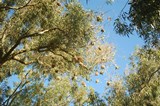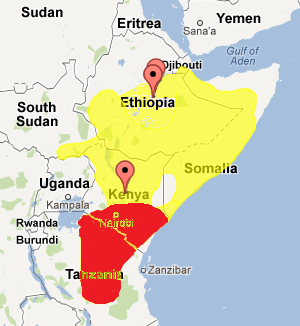Weaver news
|
The White-headed Buffalo-Weaver Dinemellia dinemelli is in the monotypic genus Dinemellia. The origin of the genus and specific name is after Dinemelli a collector in Ethiopia about whom nothing is known. The genus is unique among weavers in that the birds are largely white with orange-red rump, undertail coverts and wing shoulder (photo left, from phown 2647). The sexes are alike and the species colours of white, black and red are unmistakable in the field. Immature birds have pale orange tail coverts, rather tahn orange-red tail coverts. They forage on the ground and feed mainly on insects but also eat seeds and fruit. They favour dry bush and savanna thornveld.
Two subspecies are recognised:
The map (right) is based on Birds of Africa, but central Ethiopia has been added to the distribution here as indicated by Ash J and Atkins J (2009. Birds of Ethiopia and Eritrea. An atlas of distribution). This species is monogamous and may be a co-operative breeder. The nest built by both sexes. They build an inner herbaceous shell of dry grass stems, and then cover the top and sides with a protective layer of thorny twigs. A short entrance tube faces downwards. Nest lining of grass, leaves or feathers is added. There may be a single nest, or several nests which probably belong to the pair. Nests are placed in trees at 2-4 m above the ground. Nests may be placed in trees that have colonies of biting ants, as additional protection from predators.
Details on eggs and nestlings may be seen in the summary box here but incubation period is still unrecorded. The nests may be used by Pygmy Falcons and Cut-throat Finches. Photo left, from phown 707. There are four PHOWN records for this conspicous species but many more are needed. Please submit records to PHOWN (PHOtos of Weaver Nests) via the Virtual Museum upload site. PHOWN records for this species Previous Wedn: Blue-billed Malimbe Full weaver species list |













